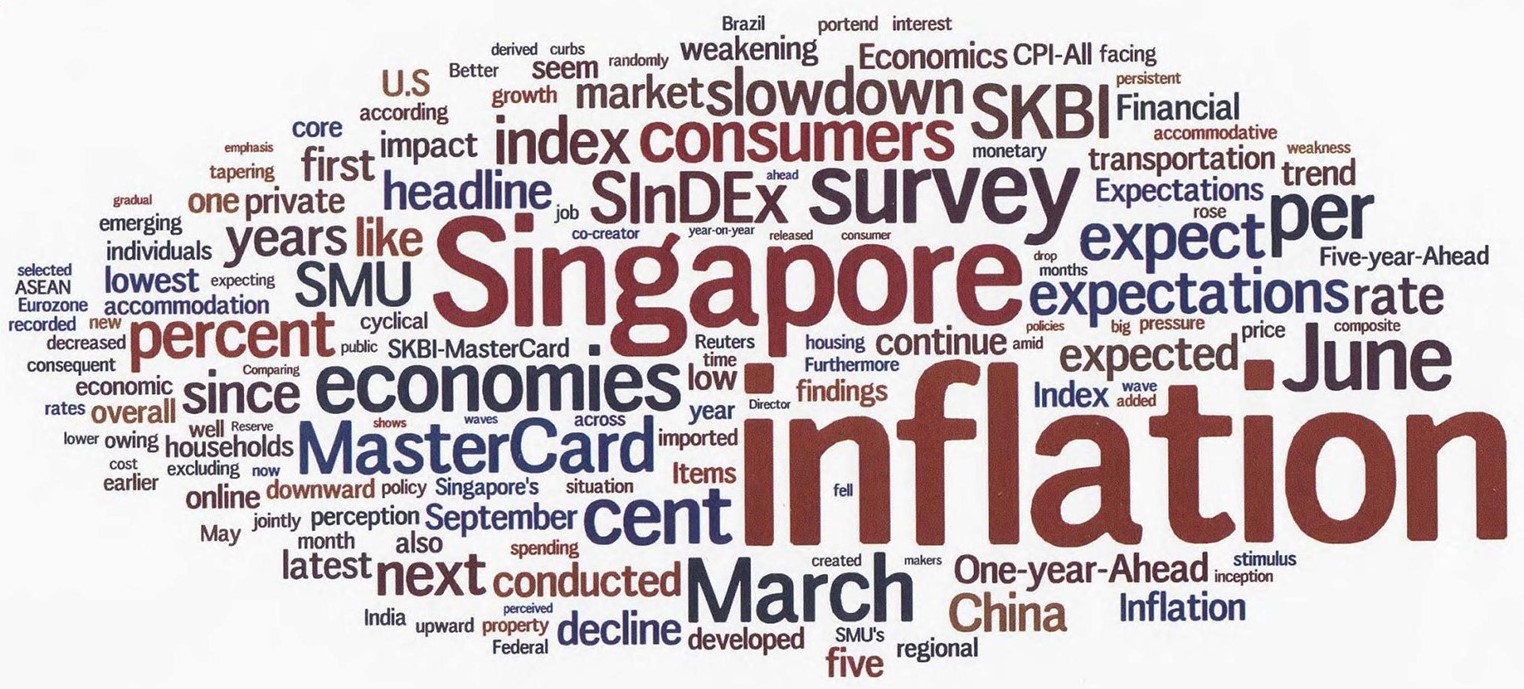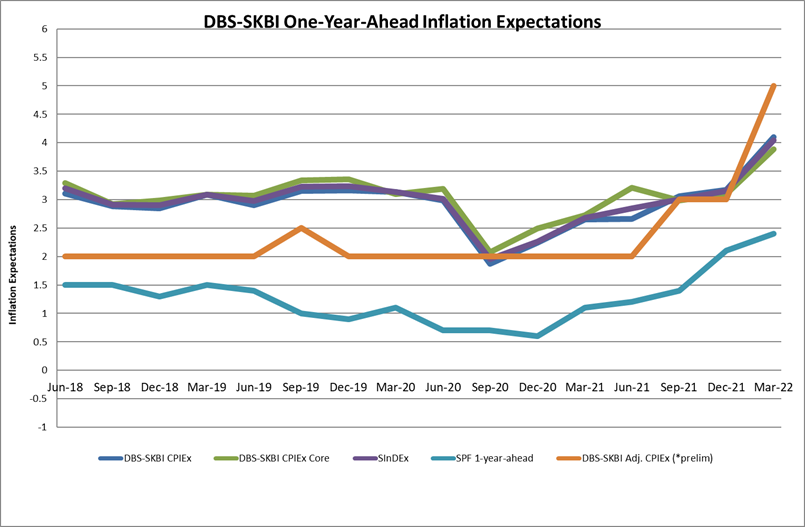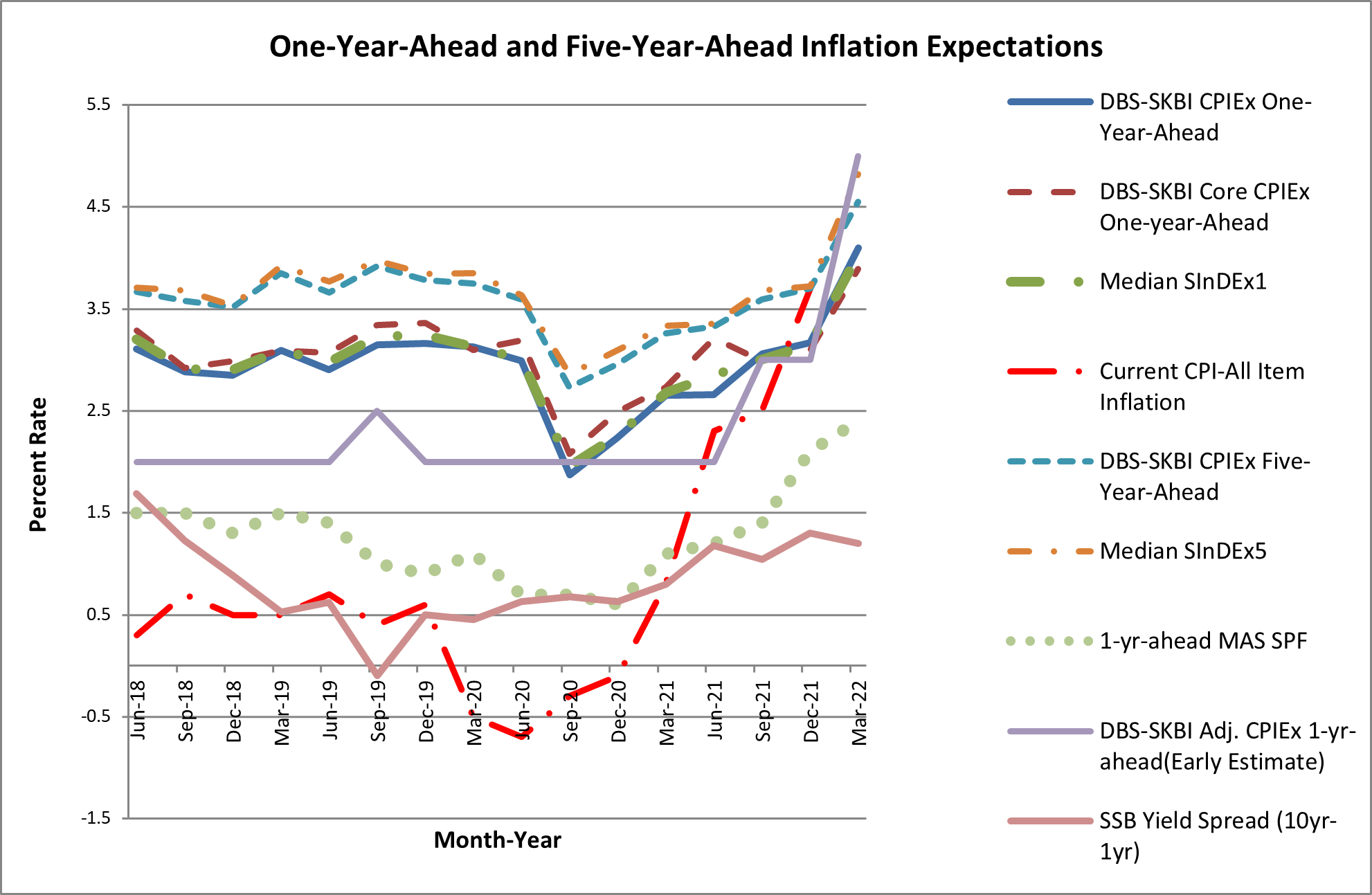
Stay tuned for more details
These are the research findings of the 42nd round of quarterly release for the DBS-SKBI Singapore Index of Inflation Expectations (SInDEx) Survey at the Sim Kee Boon Institute for Financial Economics (SKBI), Singapore Management University (SMU).

DBS Chief Economist and Managing Director of Group Research, Dr. Taimur Baig commented, “In line with global trend, especially among developed markets, Singapore has seen a steady rise in goods, energy, and services prices over the past year. Inflation expectations polled and estimated by the DBS-SKBI survey show similar trend, along with the insight that expectations are still anchored, with no sign of a sharp jump. Authorities have already begun adjusting their monetary and fiscal policy stance to address the bottoming of economic activities and rise in inflation, which ought to keep a lid on inflation expectations.”
SMU Assistant Professor of Finance and founding Principal Investigator of the DBS-SKBI SInDEx Project, Aurobindo Ghosh highlighted, “Global economy is at a crossroad. The rate of transmission of the Omicron variant, detected first in South Africa in November 2021, disrupted the gradual resumption of global travel and trade. Domestically, despite a vaccination rate of over 90% among eligible residents, broader re-opening up of the Singapore economy, including further relaxation of the safe management restrictions, had to be delayed in an abundance of caution against this highly transmissible strain. Having said that, the DBS-SKBI SInDEx survey suggests that Singaporeans seem to have priced in the new normal in forming their inflation expectations and behaviour, including having consumption baskets returning to their pre-pandemic levels (Cavallo, 2020).”
“From somewhat divergent beliefs in the September 2021 survey, we observe a broad-based decline in component-wise inflation expectations leading to a convergence of One-year-Ahead headline and core inflation expectations closer to a long-term average of about 3%, even after accommodating for behavioral and anchoring biases identified in academic literature. This convergence is potentially an effect of proactive policymaking via an unexpected tightening of the monetary policy in October 2021 and property cooling measures in December 2021 to promote a stable and sustainable property market. The inflation expectations polled in December 2021 display some degree of anchoring of medium term inflation expectations,” Prof Ghosh observed.
For the longer horizon, the Five-year-Ahead CPIEx inflation expectations decreased moderately from 3.9% in the September 2021 survey to 3.8% in December 2021. The current polled number continues to remain slightly lower than the fourth quarter average of 4.0% since the survey’s inception in 2011 till 2020.
The Five-year-Ahead CPIEx core inflation expectations (excluding accommodation and private road transportation related costs), on the other hand, remained unchanged at 3.6% in December 2021. Overall, the composite Five-year-Ahead SInDEx5 also remained unchanged at 3.7% in December. In comparison, the fourth quarter average value (since the survey’s inception in 2011 till 2020) of the composite Five-year-Ahead SInDEx5 is 3.9%.
“Responding to communications from the US Federal Reserve Board to control inflationary pressures and consensus from economists of the potential of multiple increases in the US benchmark interest rate in 2022, the International Monetary Fund (IMF) have issued a warning to emerging economies of a faster than expected increase in global interest rate which can potentially affect financial markets and depreciate currencies. Appreciating US dollar might also impact longer term inflation expectations through imported inflation (such as oil and commodity prices), while impending rollout of increased GST and domestic pass-through costs like wages and rental might impact Singaporeans’ pocketbooks. In addition, there is some evidence of pandemic restriction fatigue despite the emergence of the highly transmissible but potentially less virulent Omicron variant, as reflected in the life and livelihood debate. In December 2021, three respondents who prioritise livelihood over life for every respondent who chose life over livelihood, up from two in the September 2021 survey,” Professor Ghosh commented.

These are the research findings of the 43rd round of quarterly release for the DBS-SKBI Singapore Index of Inflation Expectations (SInDEx) Survey at the Sim Kee Boon Institute for Financial Economics (SKBI), Singapore Management University (SMU).

DBS Chief Economist and Managing Director of Group Research, Dr. Taimur Baig commented, “In line with global developments, both actual and expected inflation have picked up in Singapore. Sharp rise in food, fuel, and rents are now a global phenomenon, although the rates of increases in Singapore are more modest compared to what’s seen in the US and Europe. We think that credible policy action by the MAS will keep expectations moderate in Singapore, although the chance of expectations going back to long-term trend levels in the near-term is low. Under these circumstances of sustained price pressure, further steepening of the nominal exchange rate band by Singapore’s central bank looks justified, in our view.”
SKBI Director Professor Dave Fernandez commented, “Inflation expectations, reported inflation, and central banks are all on the move, both in Singapore and globally. Therefore, all inflation datapoints, including the ones from our survey, should be monitored closely.”
SMU Assistant Professor of Finance and founding Principal Investigator of the DBS-SKBI SInDEx Project, Aurobindo Ghosh highlighted, “It may sound like a cliché but the global inflation has been caught in a perfect storm. The reasons are manifold including disrupted reopening from the Covid-19 pandemic in major global cities like Shanghai, cyclical increase in both hard and soft commodity prices exacerbated by strife in two of the largest global exporters of food grain, continuing supply chain disruptions increasing freight time and cost, and finally, impending normalization from accommodative monetary policy which has together bought US inflation rate to 40-year highs at 8.5% in March 2022. Singapore being a small open economy is vulnerable to all these risk factors. So, it’s not surprising One-year Ahead headline and core inflation expectations jumped to over 4% for the first time in 9 years of SInDEx survey.”
“Responding to global cues, before the conflict in Ukraine, the Monetary Authority of Singapore already tightened their exchange rate based monetary policy in January 2022 and then again in April 2022 in a pre-emptive move to preclude the prospect of unhinged or unanchored inflation expectations. However, the impact of passthrough costs like rental, distribution and labour costs in a tight labour market are harder to mitigate even with the appreciating Singapore dollar against a trade weighted basket of currencies. Respondents to the survey in March 2022, corroborating academic work by Cavallo (2020), opined that their consumption basket has slightly higher expense due to energy and service costs, although impact on direct Covid-19 related expenses seem to have subsided.,” Prof Ghosh reflected.
For the longer horizon, the Five-year-Ahead CPIEx inflation expectations increased in March 2022 to 4.8% from 3.8% in December 2021. The current polled number is higher than the first quarter average of 4.1% since the survey’s inception in 2012.
The Five-year-Ahead CPIEx core inflation expectations (excluding accommodation and private road transportation related costs) also increased to 4.6% in March 2022 from 3.6% in December 2021. Overall, the composite Five-year-Ahead SInDEx5 also increased to 4.8% in March 2022, from 3.7% in December 2021. In comparison, the current polled numbers are a bit higher than the first quarter average value (since the survey’s inception in 2011 till 2021) of the composite Five-year-Ahead SInDEx5 of 3.9%.
“The silver lining for the dark cloud of higher inflation expectations is the world attention seem to be descending on inflation and steps are being taken to mitigate inflation risks, such as the releasing of a million barrel a day from strategic petroleum reserves by the US administration to ease the pressure on oil prices. In the wake of Russian aggression in Ukraine, Western European countries are also weaning off Russian oil and gas. This also might give a strong fillip towards transitioning out of fossil fuel, even though in the short to medium term higher petroleum prices, and hence bigger incentive towards alternatives is expected. For the long term, inflation expectations also seem to be swayed by the conflict and consequent price increases. In other words, there seem to be more significant structural concerns related to the impact of geopolitics on prices. This needs to be addressed for longer term anchoring of inflation expectations. Finally, on the pandemic front, our live-vs-livelihood debate seems to signal that, with widespread vaccination and boosting, even with the more transmissible but less virulent Omicron variant, for every one person who selects life over livelihood, over three respondents support the government’s push towards opening up the economy.” Prof Ghosh commented.

These are the research findings of the 44th round of quarterly release for the DBS-SKBI Singapore Index of Inflation Expectations (SInDEx) Survey at the Sim Kee Boon Institute for Financial Economics (SKBI), Singapore Management University (SMU).
- Overall, despite policy stabilisation to assuage the impact of the pandemic, given the global uncertainty and economic disruptions, Singaporean consumers felt that the pandemic will have a moderately negative impact on Singapore’s economic growth.
- Singaporean consumers also felt they will have to dole out slightly higher amount on spending owing mainly to price increases despite possible cutbacks on consumption.
- We found that the impact on inflation for Transport, Healthcare, Housing is expected to be slightly negative.
- In addition, the impact on overall One-year- Ahead inflation and Five-year -Ahead inflation is expected toto be negative but limited.
- There is however some divergence among respondents regarding the impact on inflation expectations for certain components including food, healthcare, clothing & footwear, where we find a distinct bimodal distribution.

DBS Chief Economist and Managing Director of Group Research, Dr. Taimur Baig commented, “Globally, Inflation has proven to be higher and stickier than considered likely even a few months ago, but that has yet to undermine long-term anchoring of inflation expectation in industrial economies. Singapore has been no exception, where inflation expectations have incorporated recent developments, but survey respondents express no particular alarm over the prospects of price movements in the long-run. The MAS, with its spate of four policy tightening measures since last October, has shown its resolve to keep inflation steady by deploying its suite of tools. A combination of stronger Singapore dollar, tighter domestic liquidity, and macro prudential measures in place would go a long way in keeping inflation expectations anchored, in our view.”
SKBI Director Professor Dave Fernandez commented, “With actual inflation printing higher, central bankers and markets are paying close attention to all measures of inflation expectations. Notably, in the US, after raising the Fed Funds target by 75bp, Chair Powell specifically cited the University of Michigan inflation expectations survey, saying the June reading was “quite eye-catching and we noticed that.” So far, Singapore’s inflation expectations have risen but remain anchored. The clear risk is that, without vigilant policy actions, current price pressures could bleed into expectations, making it more likely that inflation becomes more persistent.”
SMU Assistant Professor of Finance and founding Principal Investigator of the DBS-SKBI SInDEx Project, Aurobindo Ghosh highlighted, “The global economy is at a crossroads. An ominous ‘stagflation’ scenario can be detrimental to global growth even if a global recession is averted warned the World Bank in its June 2022 Global Economic Prospects report. Being a small open economy, Singapore is fairly exposed to all the headwinds afflicting the global economy including the supply chain disruptions as well as the Ukraine-Russia conflict which are escalating global inflation as evidenced from four decade high inflation in the US and have darkened global growth outlook as is evident from the stuttering growth in major economies like China. Preemptive tightening of monetary policy by the Monetary Authority of Singapore might have dampened the unhinged increase in inflation expectations, as the DBS-SKBI SInDEx inflation expectations survey suggests. However, the heightened level of uncertainty rising from the continuing conflict in Ukraine is having a debilitating impact on global production of food grains and other commodities, increase in global oil prices and potential slowdown in major economies. These might have caused the free response behaviourally adjusted inflation expectations to be significantly higher, particularly due to cognitive biases in surveys. This cognitive dissonance is reduced when we look at those respondents with higher levels of financial literacy having slightly lower inflation expectations.”
For the longer horizon, the Five-year-Ahead CPIEx inflation expectations decreased from 4.8% in the March 2022 survey to 4.5% in June 2022. The current polled number is higher than the second quarter average of 4.0% since the survey’s inception in 2012 till 2021.
The Five-year-Ahead CPIEx core inflation expectations (excluding accommodation and private road transportation related costs) also decreased to 4.3% in June 2021 from 4.6% in March 2022. Overall, the composite Five-year-Ahead SInDEx5 also decreased to 4.4% in March 2022, from 4.8% in March 2022. In comparison, the second quarter average value (since the survey’s inception in 2012 till 2021) of the composite Five-year-Ahead SInDEx5 is 3.9%.
“There are some silver linings to the generally gloomy global economic outlook. First, we find that compared to March 2022 survey, the June 2022 survey showed a decline in the long term 5-year-Ahead inflation expectations though still above the historical average. Second, there is more stabilisation in the life vs livelihood debate where for every person choosing life over livelihood, about 3.4 choose livelihood over life, almost unchanged from the March 2022 survey. Finally, the survey indicated that while Singaporeans feel overall economic growth will be dampened moderately in the medium term, they are expecting that some price increases might lead to slightly higher expense with some adjustment in consumption baskets. This is signalling that we have approached a new normal of endemic Covid-19 and hopefully some degree of anchoring of long term inflation expectations,” Prof Ghosh commented.


Stay tuned for more details
Get updates on SKBI news and forthcoming events.
*Please note that upon providing your consent to receive marketing communications from SMU SKBI, you may withdraw your consent, at any point in time, by sending your request to skbi_enquiries [at] smu.edu.sg (subject: Withdrawal%20consent%20to%20receive%20marketing%20communications%20from%20SMU) . Upon receipt of your withdrawal request, you will cease receiving any marketing communications from SMU SKBI, within 30 (thirty) days of such a request.